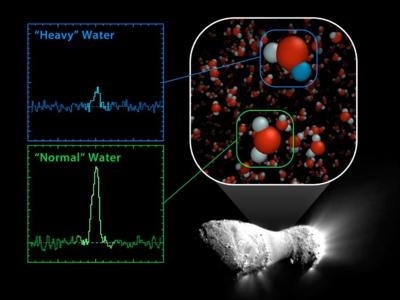Water Source Found In Pluto's Neighborhood
Astronomers have found a new cosmic source for the same kind of
water that appeared on Earth billions of years ago and created the
oceans. The findings may help explain how Earth's surface ended up
covered in water. New measurements from the Herschel Space
Observatory show that comet Hartley 2, which comes from the distant
Kuiper Belt, contains water with the same chemical signature as
Earth's oceans. This remote region of the solar system, some 30 to
50 times as far away as the distance between Earth and the sun, is
home to icy, rocky bodies including Pluto, other dwarf planets and
innumerable comets.
NASA Image

"Our results with Herschel suggest that comets could have played
a major role in bringing vast amounts of water to an early Earth,"
said Dariusz Lis, senior research associate in physics at the
California Institute of Technology in Pasadena and co-author of a
new paper in the journal Nature, published online Oct. 5. "This
finding substantially expands the reservoir of Earth ocean-like
water in the solar system to now include icy bodies originating in
the Kuiper Belt."
Scientists theorize Earth started out hot and dry, so that water
critical for life must have been delivered millions of years later
by asteroid and comet impacts. Until now, none of the comets
previously studied contained water like Earth's. However,
Herschel's observations of Hartley 2, the first in-depth look at
water in a comet from the Kuiper Belt, paint a different
picture.
Herschel peered into the comet's coma, or thin, gaseous
atmosphere. The coma develops as frozen materials inside a comet
vaporize while on approach to the sun. This glowing envelope
surrounds the comet's "icy dirtball"-like core and streams behind
the object in a characteristic tail. Herschel detected the
signature of vaporized water in this coma and, to the surprise of
the scientists, Hartley 2 possessed half as much "heavy water" as
other comets analyzed to date. In heavy water, one of the two
normal hydrogen atoms has been replaced by the heavy hydrogen
isotope known as deuterium. The ratio between heavy water and
light, or regular, water in Hartley 2 is the same as the water on
Earth's surface. The amount of heavy water in a comet is related to
the environment where the comet formed.
By tracking the path of Hartley 2 as it swoops into Earth's
neighborhood in the inner solar system every six and a half years,
astronomers know that it comes from the Kuiper Belt. The five
comets besides Hartley 2 whose heavy-water-to-regular-water ratios
have been obtained all come from an even more distant region in the
solar system called the Oort Cloud. This swarm of bodies, 10,000
times farther afield than the Kuiper Belt, is the wellspring for
most documented comets.

Given the higher ratios of heavy water seen in Oort Cloud comets
compared to Earth's oceans, astronomers had concluded that the
contribution by comets to Earth's total water volume stood at
approximately 10 percent. Asteroids, which are found mostly in a
band between Mars and Jupiter but occasionally stray into Earth's
vicinity, looked like the major depositors. The new results,
however, point to Kuiper Belt comets having performed a previously
under-appreciated service in bearing water to Earth.
How these objects ever came to possess the tell-tale oceanic
water is puzzling. Astronomers had expected Kuiper Belt comets to
have even more heavy water than Oort Cloud comets because the
latter are thought to have formed closer to the sun than those in
the Kuiper Belt. Therefore, Oort Cloud bodies should have had less
frozen heavy water locked in them prior to their ejection to the
fringes as the solar system evolved.
"Our study indicates that our understanding of the distribution
of the lightest elements and their isotopes, as well as the
dynamics of the early solar system, is incomplete," said co-author
Geoffrey Blake, professor of planetary science and chemistry at
Caltech. "In the early solar system, comets and asteroids must have
been moving all over the place, and it appears that some of them
crash-landed on our planet and made our oceans."
Herschel is a European Space Agency cornerstone mission, with
science instruments provided by consortia of European institutes.
NASA's Herschel Project Office is based at the agency's Jet
Propulsion Laboratory in Pasadena, Calif., which contributed
mission-enabling technology for two of Herschel's three science
instruments. The NASA Herschel Science Center, part of the Infrared
Processing and Analysis Center at Caltech in Pasadena, supports the
U.S. astronomical community.
 ANN's Daily Aero-Linx (04.16.24)
ANN's Daily Aero-Linx (04.16.24) Aero-News: Quote of the Day (04.16.24)
Aero-News: Quote of the Day (04.16.24) Airborne 04.10.24: SnF24!, A50 Heritage Reveal, HeliCycle!, Montaer MC-01
Airborne 04.10.24: SnF24!, A50 Heritage Reveal, HeliCycle!, Montaer MC-01 Airborne 04.12.24: SnF24!, G100UL Is Here, Holy Micro, Plane Tags
Airborne 04.12.24: SnF24!, G100UL Is Here, Holy Micro, Plane Tags Airborne-Flight Training 04.17.24: Feds Need Controllers, Spirit Delay, Redbird
Airborne-Flight Training 04.17.24: Feds Need Controllers, Spirit Delay, Redbird




